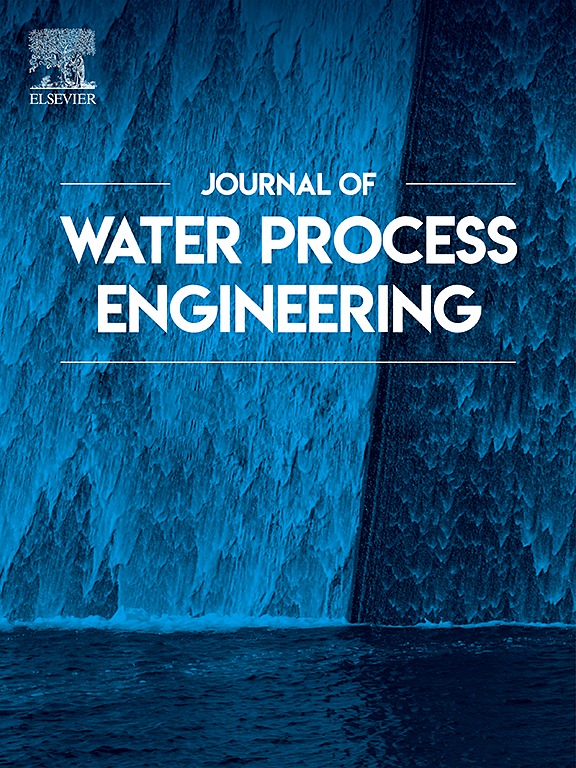Critical role of pH in wastewater treatment and resource recovery from the hazardous chemical polishing wastewater
IF 6.3
2区 工程技术
Q1 ENGINEERING, CHEMICAL
引用次数: 0
Abstract
Chemical polishing (CP) wastewater offers enormous potential for phosphorus recovery. This study focused on the Al3+ removal and phosphate recovery from the CP wastewater by electrochemical (EC) treatment combined with the chemical precipitation method. EC systems with two configurations were established, and multiple batch cycles were operated. The chemical precipitation simulation and Pearson correlation analysis show that the removal pathways of phosphate and Al3+ were divided into three steps based on the increasing pH. Step I was the hydrogen reaction to increase pH from 1.21 to 2.78, and then the electrode reaction increased pH from 2.78 to 3.60, named step II. Step III was increasing pH from 3.60 to 7.00 by the addition of NaOH. Al3+ was mainly removed as Al(PO)4 in step II, and phosphate was mainly recovered as vivianite in Step III. The higher pH could increase the Fe(II)/P molar ratio by reducing phosphate concentration in step II, and the higher Fe(II)/P molar ratio could improve vivianite purity in step III. The EC system can run stably for 15 days with a removal efficiency of 99 % and vivianite purity of 57 %. These findings could be exploited for more industrial wastewater treatment, advancing the practical application of EC technology.
pH值在危险化学抛光废水处理和资源化利用中的关键作用
化学抛光废水具有巨大的磷回收潜力。研究了电化学-化学沉淀法联合处理CP废水中Al3+的去除和磷酸盐的回收。建立了两种结构的EC系统,并进行了多批循环运行。化学沉淀模拟和Pearson相关分析表明,磷酸盐和Al3+的去除途径根据pH的增加分为三个步骤,第一步是氢反应将pH从1.21提高到2.78,然后电极反应将pH从2.78提高到3.60,称为步骤II。第三步通过添加NaOH将pH从3.60提高到7.00。Al3+在步骤II中主要以Al(PO)4的形式被去除,磷酸盐在步骤III中主要以橄榄石的形式被回收。较高的pH值可以通过降低第二步的磷酸盐浓度来提高铁(II)/磷的摩尔比,较高的pH值可以提高第三步的铁(II)/磷的摩尔比。该系统可稳定运行15天,去除率为99%,活石纯度为57%。这些发现可以用于更多的工业废水处理,促进EC技术的实际应用。
本文章由计算机程序翻译,如有差异,请以英文原文为准。
求助全文
约1分钟内获得全文
求助全文
来源期刊

Journal of water process engineering
Biochemistry, Genetics and Molecular Biology-Biotechnology
CiteScore
10.70
自引率
8.60%
发文量
846
审稿时长
24 days
期刊介绍:
The Journal of Water Process Engineering aims to publish refereed, high-quality research papers with significant novelty and impact in all areas of the engineering of water and wastewater processing . Papers on advanced and novel treatment processes and technologies are particularly welcome. The Journal considers papers in areas such as nanotechnology and biotechnology applications in water, novel oxidation and separation processes, membrane processes (except those for desalination) , catalytic processes for the removal of water contaminants, sustainable processes, water reuse and recycling, water use and wastewater minimization, integrated/hybrid technology, process modeling of water treatment and novel treatment processes. Submissions on the subject of adsorbents, including standard measurements of adsorption kinetics and equilibrium will only be considered if there is a genuine case for novelty and contribution, for example highly novel, sustainable adsorbents and their use: papers on activated carbon-type materials derived from natural matter, or surfactant-modified clays and related minerals, would not fulfil this criterion. The Journal particularly welcomes contributions involving environmentally, economically and socially sustainable technology for water treatment, including those which are energy-efficient, with minimal or no chemical consumption, and capable of water recycling and reuse that minimizes the direct disposal of wastewater to the aquatic environment. Papers that describe novel ideas for solving issues related to water quality and availability are also welcome, as are those that show the transfer of techniques from other disciplines. The Journal will consider papers dealing with processes for various water matrices including drinking water (except desalination), domestic, urban and industrial wastewaters, in addition to their residues. It is expected that the journal will be of particular relevance to chemical and process engineers working in the field. The Journal welcomes Full Text papers, Short Communications, State-of-the-Art Reviews and Letters to Editors and Case Studies
 求助内容:
求助内容: 应助结果提醒方式:
应助结果提醒方式:


